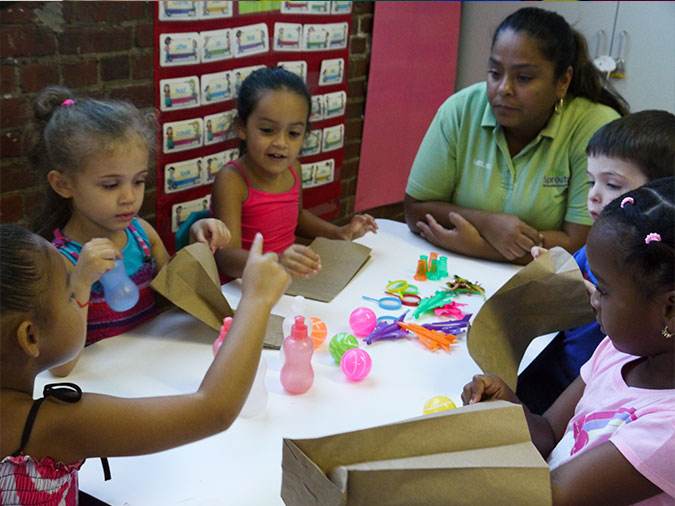Children share objects equally to make pretend entertainment kits and lunches.
Materials

- Different types of plastic food or entertainment items (5 or more of each type), e.g., plastic toys, puzzles, balls, markers and pads, stickers. Alternative: Use materials on hand, such as images of food cut from magazines.
- 5 or more paper bags
Preparation
- Place the paper bags on the table. Mix up the entertainment items or plastic foods and place on the table.
Directions
- Tell the children that in this activity, they will work together to make pretend lunches for a picnic or entertainment kits for a car ride. First, they must sort the items into groups, and then they must share the items equally, so that each bag has the same types of food/entertainment items and the same amount of each. (Note: It is okay if there are more or fewer children than bags since this is a group task and they are not creating their own individual bags.)
- If needed, support the children’s sorting of the items into similar groups by asking, How are these items the same (or different)? Can you put all the items that are the same in this pile? Once the task is completed, ask children to count, How many of each item do we have? How many bags do we have? How many of each item do you think should go in each bag?
- Facilitate as the children divide the items equally among the bags. Ask, How can you figure out how many toys go in each bag?
- Once all the items are packed, use any of the following strategies to check that they have been shared equally:
- Your or the children can count the items in each bag.
- The children can line up their collections to compare them. Ask, Does anyone have too many? Too few?
- If the items were not shared equally, ask, How do you think you could share the food equally?
- Change the number of bags and/or items. Have the children repeat the activity with the new number of bags and items.
- You might also increase the challenge by having an uneven number of items for the children to share equally (for instance, 5 bags and only 3 plastic apples). In this case, hold a discussion with the children about how they might share the apples equally (cut them up in equal slices, hold the apples for a different use). You won’t be able to share the apples equally (since they are plastic), but it will trigger an interesting discussion and creative thinking.

